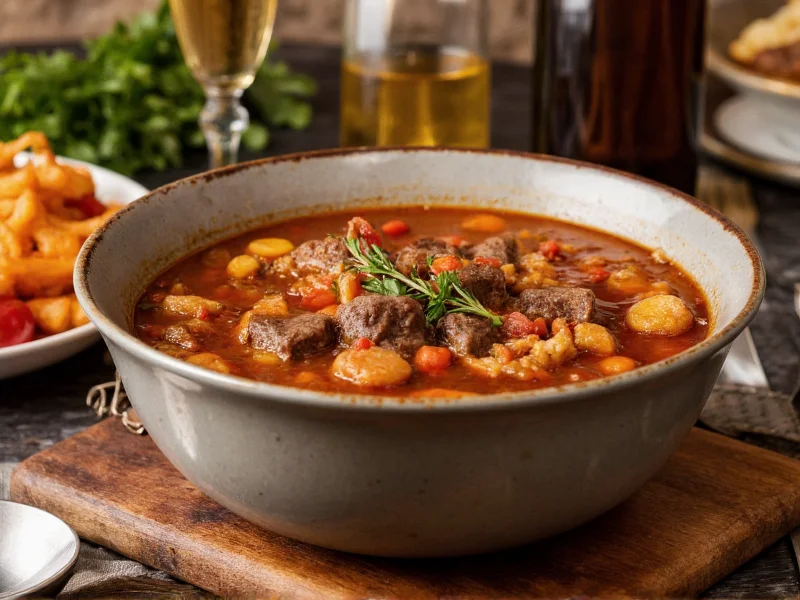Creating exceptional steak soup begins with understanding the fundamental components that transform simple ingredients into a restaurant-quality meal. Unlike basic beef soups, authentic steak soup features premium cuts of meat that maintain their structure while infusing the broth with rich flavor. The magic happens through proper searing technique and controlled simmering that develops complex flavors without overcooking the beef.
Essential Ingredients for Perfect Steak Soup
Selecting quality ingredients forms the foundation of memorable steak soup. For the meat component, choose well-marbled cuts like chuck roast, sirloin, or ribeye trimmed to 1-inch cubes. These cuts contain the ideal fat-to-lean ratio that melts during cooking, enriching the broth naturally. Avoid lean cuts like round steak which become tough when simmered.
Vegetable selection significantly impacts flavor depth. Traditional steak soup ingredients include:
| Vegetable | Preparation | Flavor Contribution |
|---|---|---|
| Yellow onions | 1 large, diced | Sweetness and aromatic base |
| Carrots | 2 medium, sliced | Natural sweetness and color |
| Celery | 2 stalks, diced | Earthy complexity |
| Garlic | 3 cloves, minced | Pungent depth |
Step-by-Step Steak Soup Preparation Guide
The cooking process separates adequate steak soup from extraordinary versions. Begin by patting meat cubes completely dry—a crucial step for proper searing. Heat 2 tablespoons of oil in a heavy-bottomed pot over medium-high heat until shimmering. Working in batches to avoid overcrowding, sear steak pieces for 2-3 minutes per side until a rich brown crust forms. Remove meat and set aside.
For the flavor base, sauté onions, carrots, and celery for 8-10 minutes until softened but not browned. Add garlic and tomato paste, cooking for 1 minute until fragrant. Deglaze the pot with 1 cup of dry red wine, scraping up all browned bits from the bottom—a process called fond collection that adds tremendous depth.
Simmering Techniques for Optimal Results
Return the seared steak to the pot along with 6 cups of quality beef broth. Add 2 bay leaves, 1 teaspoon thyme, and 1 teaspoon Worcestershire sauce. Bring to a gentle simmer—never a rolling boil—as high heat will make the meat tough. Skim any foam that rises to the surface during the first 15 minutes.
Cover and maintain a bare simmer for 1.5 hours. The ideal steak soup cooking time allows collagen to break down into gelatin while keeping meat tender. After 60 minutes, add diced potatoes and additional vegetables like peas or green beans. Continue simmering for another 30 minutes until vegetables reach desired tenderness.
Popular Steak Soup Variations
Regional adaptations offer exciting twists on traditional steak soup recipes. French-inspired versions incorporate mushrooms and pearl onions, while Korean-style steak soup (Sogogi Gomguk) features ginger and garlic broth with sliced beef brisket. For weeknight convenience, try these adaptations:
- Slow cooker steak soup: After initial searing, transfer all ingredients to a slow cooker and cook on low for 6-8 hours
- Healthy steak soup options: Substitute half the meat with mushrooms and use low-sodium broth
- Steak soup with barley: Add 1/2 cup pearl barley with the broth for added texture and fiber
- Spicy steak soup variation: Include 1 diced jalapeño and 1 teaspoon smoked paprika
Serving and Storage Recommendations
For the best steak soup experience, allow the soup to rest for 15 minutes after cooking before serving. This resting period lets flavors meld and makes the meat easier to portion. Garnish with fresh parsley and serve with crusty bread for dipping. Leftovers actually improve overnight as flavors continue developing.
Proper storage maintains quality:
- Cool completely within 2 hours of cooking
- Store in airtight containers for up to 4 days in the refrigerator
- Freeze portions for up to 3 months
- Reheat gently on the stove, adding broth if needed
Troubleshooting Common Steak Soup Issues
Even experienced cooks encounter challenges with steak soup preparation. If your broth lacks depth, try these solutions:
- Bland broth: Add 1-2 anchovy fillets while sautéing vegetables (they'll dissolve completely) or a Parmesan rind during simmering
- Tough meat: You likely boiled instead of simmered—future batches require lower temperature
- Excess fat: Chill soup overnight and skim solidified fat from the surface before reheating
- Overly salty: Add raw potato chunks to absorb excess salt, or dilute with unsalted broth
Nutritional Profile and Dietary Considerations
A standard 1.5-cup serving of traditional steak soup contains approximately 380 calories, 28g protein, 22g fat (9g saturated), and 18g carbohydrates. To create lighter steak soup options, trim all visible fat from meat before cooking and use low-sodium broth. For keto-friendly versions, omit starchy vegetables and increase low-carb options like mushrooms and spinach.
Steak soup provides significant nutritional benefits including:
- Complete protein source supporting muscle maintenance
- Iron and zinc from beef for blood health
- Vitamin A from carrots for eye health
- Collagen from slow cooking that supports joint health











 浙公网安备
33010002000092号
浙公网安备
33010002000092号 浙B2-20120091-4
浙B2-20120091-4